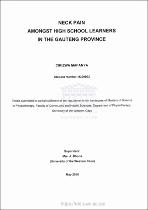| dc.contributor.advisor | Rhoda, A. | |
| dc.contributor.author | Mafanya, Cikizwa | |
| dc.date.accessioned | 2022-10-06T08:19:13Z | |
| dc.date.available | 2022-10-06T08:19:13Z | |
| dc.date.issued | 2010 | |
| dc.identifier.uri | http://hdl.handle.net/11394/9335 | |
| dc.description | >Magister Scientiae - MSc | en_US |
| dc.description.abstract | The prevalence of musculoskeletal pain is rising in adolescents and this may be due to new information technology leading to increased computer use, involving repetitive movements and static postures. Adolescent neck pain has not been identified as a widespread problem in South Africa due to limited local research, yet globally the prevalence is increasing at a rapid rate. The researcher has observed a number of school learners presenting with neck pain. The aim of the study was to determine the prevalence of and factors affecting neck pain at two conveniently selected high schools in the Gauteng Province, South Africa. A quantitative descriptive cross-sectional study was performed
on a sample of 181 conveniently selected high school learners. A valid, reliable questionnaire which investigated the prevalence of neck pain as well as involvement in sports activities, recreational activities! and the use of computers was used to collect the data .. To determine neck flexor muscle endurance, the neck flexor muscle endurance the neck flexor muscle endurance test was used. SPSS version 16.0 was used to analyze the data. Contributing factors were assessed using Chi square and the Fisher's exact tests. The significance level was set at p<0.05. Logistic regression analysis was used to analyze to analyze the effect of the independent variables on the dependent pain. The necessary ethical considerations were adhered to during study. Ethical clearance was obtained from the research grants and study leave at the University of the Western Cape. A total of 181 learners participated in the study. Of the learners who participated, 125 five used computers at school and 32% of the learners used computers at least twice per week. A total of,97(53.6%) learners reported to have experienced neck pain. In the study the following were identified as predictive factors for occurrence of neck pain: computer use at home (OR 2.30; 95CI: 1.07- 4.94), neck flexor muscle endurance (OR .79, 95 C; 0.69- 0.90) and age (OR 2.52; 95CI: 1.18- 5.40). The study is of vital importance to the learners', educators as well as health care professionals as prevention of the predisposing factors helps to lessen the number of absenteeism and improve the learner's performance. | en_US |
| dc.language.iso | en | en_US |
| dc.publisher | University of the Western Cape | en_US |
| dc.subject | Sternocleidomastoid (SCM) | en_US |
| dc.subject | Gauteng Province | en_US |
| dc.subject | Neck pain | en_US |
| dc.subject | Prevalence | en_US |
| dc.subject | Adolescents | en_US |
| dc.subject | Physical activity | en_US |
| dc.subject | Computer use | en_US |
| dc.subject | Neck flexor muscle endurance | en_US |
| dc.title | Neck pain amongst high school learners in the Gauteng province | en_US |
| dc.rights.holder | University of the Western Cape | en_US |

